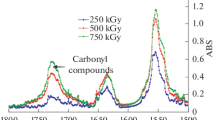Summary
An improved apparatus was constructed for the direct observation of the changes which take place in the solution above 100° C. By means of this apparatus the behaviors of the solutions of the salts of thorium and uranium were studied up to 200° C. When the concentrations lie within a certain range, turbidity appears above 100° C in the solutions of thorium chloride and nitrate as a consequence of hydrolysis. The results are expressed by means of a curve, concentration vs. temperature of turbidity formation. Similar curves are obtained for the chloride and nitrate. The necessity is suggested, for the salts which hydrolyze, to study the concentration range in which turbidity formation takes place.
The solutions of uranyl chloride and nitrate are very stable, and they show no decomposition up to 200° C. Thermochromism, which is attributed to the action of UO2++, is observed in the solution of uranyl chloride.
No induced precipitation of uranium takes place when the mixtures consisting of the salts of thorium and uranium are autoclaved at 200° C.
Zusammenfassung
Für die direkte Beobachtung der in der Lösung bei über 100° C stattfindenden Veränderungen wurde ein verbesserter Apparat konstruiert. Mit diesem wurden die Veränderungen der Salzlösungen von Thorium und Uran bis zu 200° C studiert.
Die durch die Hydrolyse bei über 100° C verursachte Trübung findet in den Lösungen von Thoriumchlorid und Thoriumnitrat statt, falls die Konzentrationen der Lösungen in einem bestimmten Bereich liegen. Die Resultate sind als Kurven, Konzentration vs. Temperatur des Auftretens der Trübung ausgedrückt. Die Kurven sind für Chlorid und Nitrat ähnlich. Für die hydrolysierenden Salze wurde auf die Notwendigkeit hingewiesen, den Konzentrationsbereich zu studieren, in welchem Trübung stattfindet.
Die Lösungen von Uranylchlorid und Uranylnitrat sind sehr stabil. Keine Zersetzung findet bei 200° C statt. Thermochromie wurde in der Lösung von Uranylchlorid beobachtet. Diese Erscheinung ist der Wirkung von UO2++ zuzuschreiben.
Keine gegenseitige Ausfällung findet statt, wenn die aus den Salzen von Thorium und Uran bestehenden Mischungen bei 200° C autoklaviert werden.
Similar content being viewed by others
References
Katsurai, T., T. Okubo andH. Mikawa, Kolloid-Z.154, 56 (1957).
Katsurai, T. andM. Tanaka, Ibid.158, 58 (1958).
Katsurai, T. andK. Sone, Ibid.163, 70 (1959).
Katsurai, T. andA. Kitahara, Ibid.148, 155 (1956).
Author information
Authors and Affiliations
Additional information
Research collaborator at the University of Arkansas (on leave of absence from the Pilot Laboratory, Hiratsuka-Kanagawa, Japan).
Rights and permissions
About this article
Cite this article
Katsurai, T. Studies on the hydrothermal changes of the solutions of the salts of thorium and uranium by means of visual autoclaving. Kolloid-Zeitschrift 170, 57–60 (1960). https://doi.org/10.1007/BF01520074
Received:
Issue Date:
DOI: https://doi.org/10.1007/BF01520074



